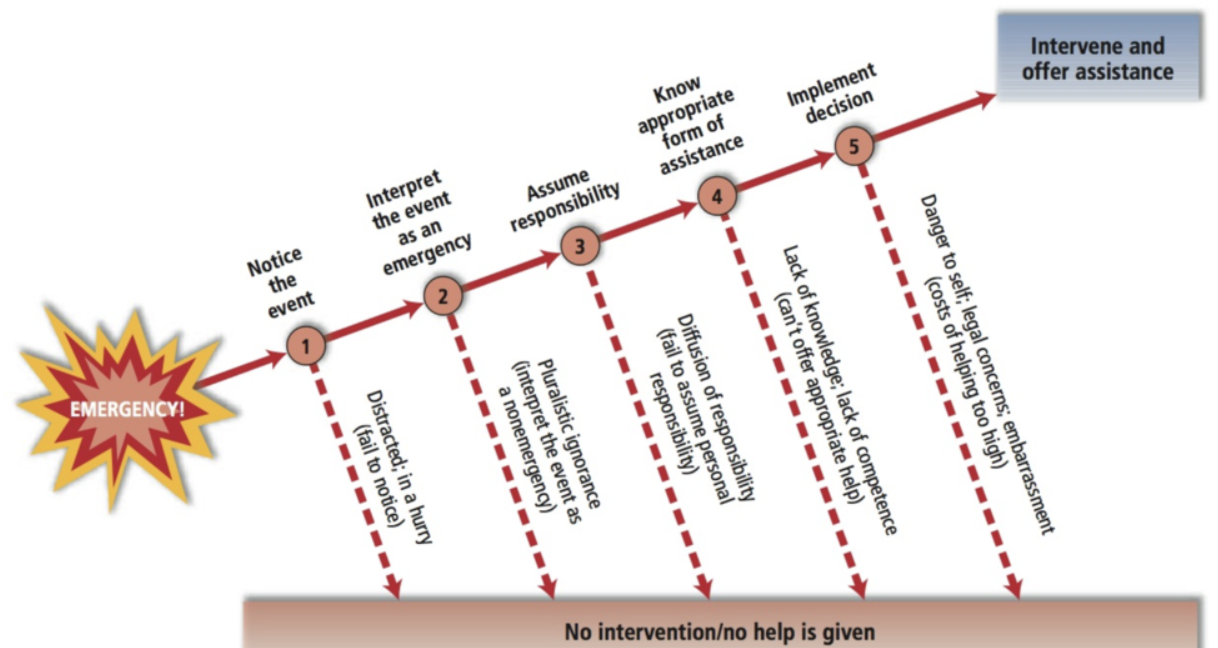A Bystander’s Dilemma: Help or Hide?

I don’t know about you, but I always feel a surge of motivation to be active in the summer. In summer of 2017, I was determined to become a seasoned runner, so I took to the treadmill. I truly surprised myself, sticking to my routine of two to three miles a day, that is until my runs took a turn for the worse. One day during my cool-down, I lost consciousness mid-walk, causing me to fall off the treadmill and to suffer a head injury. I know…I, too, am laughing at the idea of me flying off a treadmill, though this situation was much worse than it sounds. In fact, it ended with me rushing to the hospital due to my inability to form comprehensible sentences or to recall any events from the situation. You may be wondering, then, how I am recounting the story now. Well, fast forward to my conversation with the doctor in the emergency room. I was unable to remember enough information about how I got to passing out, so the doctor requested video footage from the workout room in my apartment complex to formulate a better picture.
Obviously, the part of the video in which I flew off the treadmill was hilarious, but what really interests us here is what happened before the fall. In the video, you can see a singular man in the room glancing at me as my body begins to go limp, pause, and continue walking. Approximately 30 seconds after this encounter, I lost consciousness and fell to the floor. The first question becomes: why didn’t he help me? According to the concept of diffusion of responsibility, the fewer the number of bystanders, the more likely one is to engage in prosocial behavior. He was the only person in the room, so why didn’t he feel obliged to help? To try to further understand this, why don’t we look at the Five Step Process to Bystander Intervention. First, he certainly noticed the event, as he looked directly at me as I started to slouch over the treadmill. Second, it is unclear if he interpreted the event as an emergency because he did not look too concerned at the sight of my limp body. Third, he could have failed to assume personal responsibility for the intervention, in which case he would have recognized the event as an emergency but not taken it upon himself to help. I would hypothesize, however, that the man didn’t interpret my situation as an emergency, which eliminates the possibility of the remaining steps: assuming responsibility, knowing how to help and deciding how to help. As we know, if bystanders fail to take any of the five steps along the intervention tree, helping behavior is not likely.
The other person who came across me was a lady who walked into the gym and saw me lying on the floor. I remember her asking me if I was alright and replying casually with, “Oh, I was just taking a nap.” If anything, this speaks to the mental state I was in at the time. Here, the woman clearly noticed the event (my unconscious self on the floor), interpreted it as an emergency, and assumed it her responsibility to ask if I was okay. However, despite being in a noticeably terrible cognitive state, she left me to wander 10 flights of stairs in search of my apartment! To this day, I am still amazed that I found my way back. I can’t help but wonder what the woman was thinking. Maybe she thought that merely asking if I was alright served as sufficient help. After all, she did decide to intervene in my situation, so one could include that she successfully completed all five steps of the bystander intervention tree.
This situation brings up the larger question of what constitutes helping behavior. How do we define helping and why do some people help more than others? In my experience, I certainly appreciated the woman checking on me, though I was left pondering about the motivation behind her actions. Did her approaching me relieve the distress posed by the sight of my body on the floor? Did the act of making sure I was okay bolster her feelings of self-worth as someone who looks out for others? Did she merely want to provide help regardless of personal gain? This debate has to do with social exchange theory – a theory holding that much of what we do stems from the desire to maximize our rewards and to minimize our costs – and the concept of altruism, or the desire to help another person even if it involves a cost to the helper.
There is no way for me to know this woman’s intentions for certain, but this situation in combination with the social psychology concepts covered in class have profoundly impacted the way I view prosocial behavior. Moving forward, I have made a promise to myself that I will not let the diffusion of responsibility prevent me from offering assistance to someone in need. In terms of offering assistance, I mean assessing the situation and providing the best help that I possibly can in that moment. Above all, the process of recounting and reflecting on this story has demonstrated the power of education and how learning about these social psychological concepts can motivate people to become more conscious and helpful citizens.
0 Comments